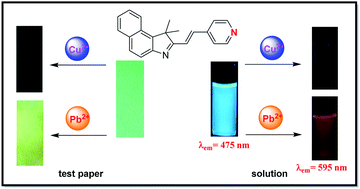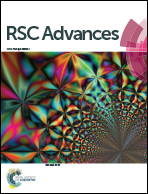A new fluorescent probe based on styrylcyanine dye containing pyridine: dissimilar fluorescent response to Cu2+ and Pb2+†
Abstract
A highly sensitive fluorescent probe (1) based on styrylcyanine dye for Cu2+ and Pb2+ has been developed. Probe 1 exhibited fluorescent turn-off sensing ability to Cu2+. On the other hand, 1 displayed ratiometric fluorescent response towards Pb2+ with a distinct fluorescent color change from blue to orange. The 1H NMR titrations revealed that the fluorescent response of 1 to Cu2+ and Pb2+ is triggered by the interaction of the pyridine unit and the metal ion. Detection limits of 1 to Cu2+ or Pb2+ were calculated as 1.24 and 3.41 × 10−6 M, respectively, by standard deviation and linear fitting. Furthermore, 1 can also be used as a sensor for detection of Cu2+ and Pb2+ in a test strip.


 Please wait while we load your content...
Please wait while we load your content...